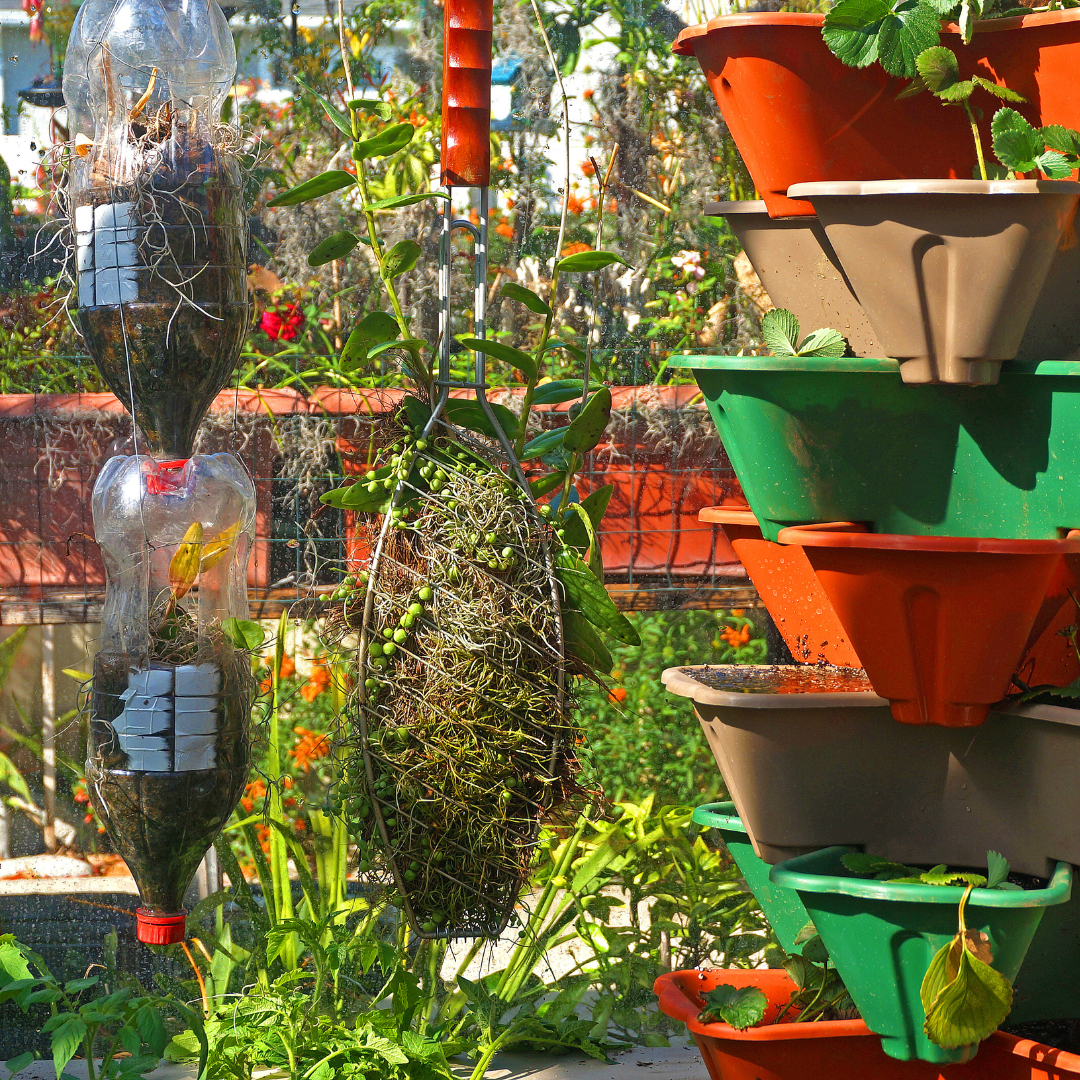Vertical gardening plants.
Are you ready to learn the best hacks for vertical gardening plants for small spaces? If you’re like me, living in a cozy space with limited outdoor area, or perhaps you’re an urban dweller craving a touch of green on your small patio, then you’re in for a treat! Stick around and I’ll uncover the most ingenious hacks to transform your small spaces into lush green paradises that grow an abundance of homegrown food!
From hand-picking the perfect plants to exploring creative solutions and sharing maintenance secrets, I’m here to guide you every step of the way. Let’s cultivate a thriving vertical garden that not only adds beauty, but also fills your surroundings with charm, life, and food!
This is a pinnable post. Tap or hover over any image in this post to pin to your Pinterest Boards.

Introduction to Vertical Gardening Plants In Small Spaces
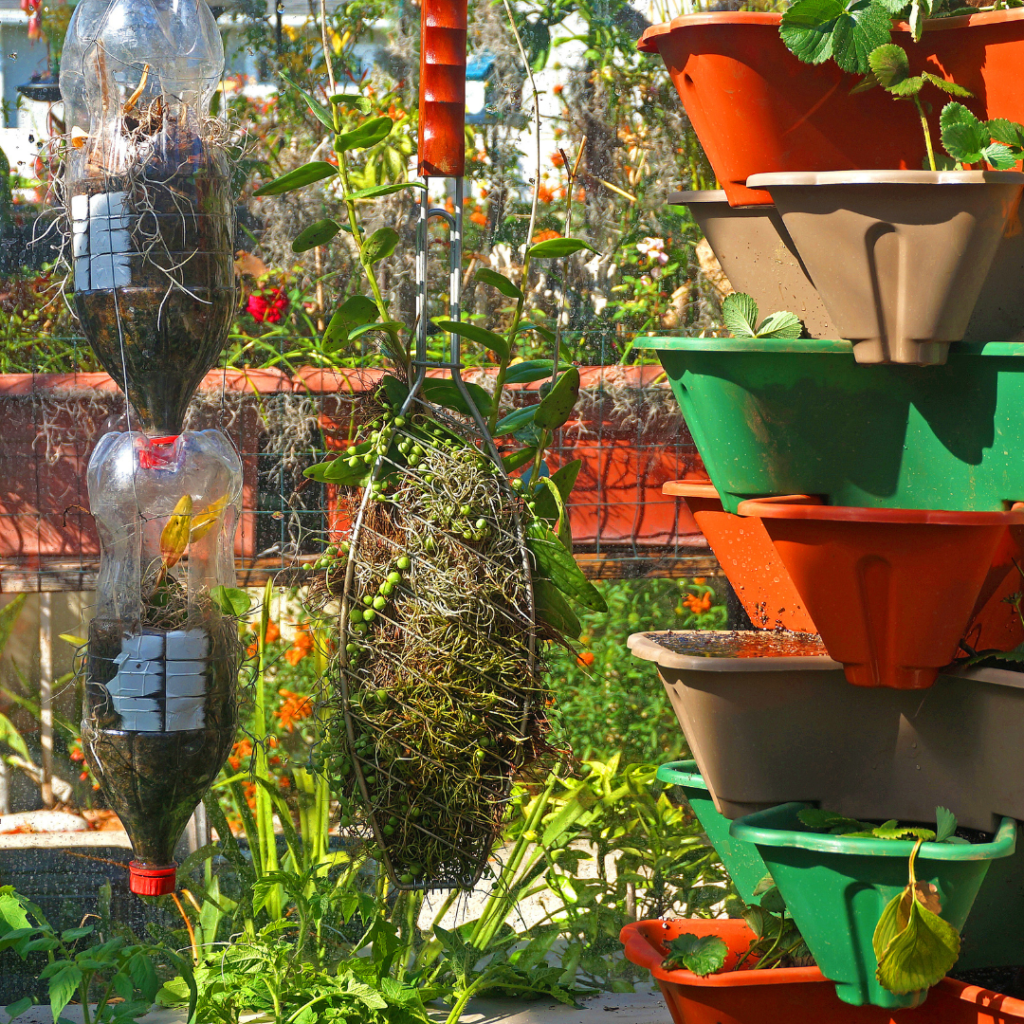
Let’s talk about my absolute favorite topic, the magic of vertical gardening in small spaces. I’m beyond excited to share my passion for turning even the tiniest corners into vibrant green oases! Picture this: lush foliage cascading down walls, colorful blooms dancing in the breeze, all within arm’s reach, no matter how limited your space!
As we kick off on this journey together, I’ll be your guide, sharing all the tips, tricks, and insider secrets to make your vertical garden dreams a reality. Get ready to unleash your creativity, because, with a sprinkle of imagination and a dash of greenery, I’ll transform your space into a botanical wonderland! It all starts with choosing the right type of plants for vertical gardening.
Choosing the Right Plants for Vertical Gardening
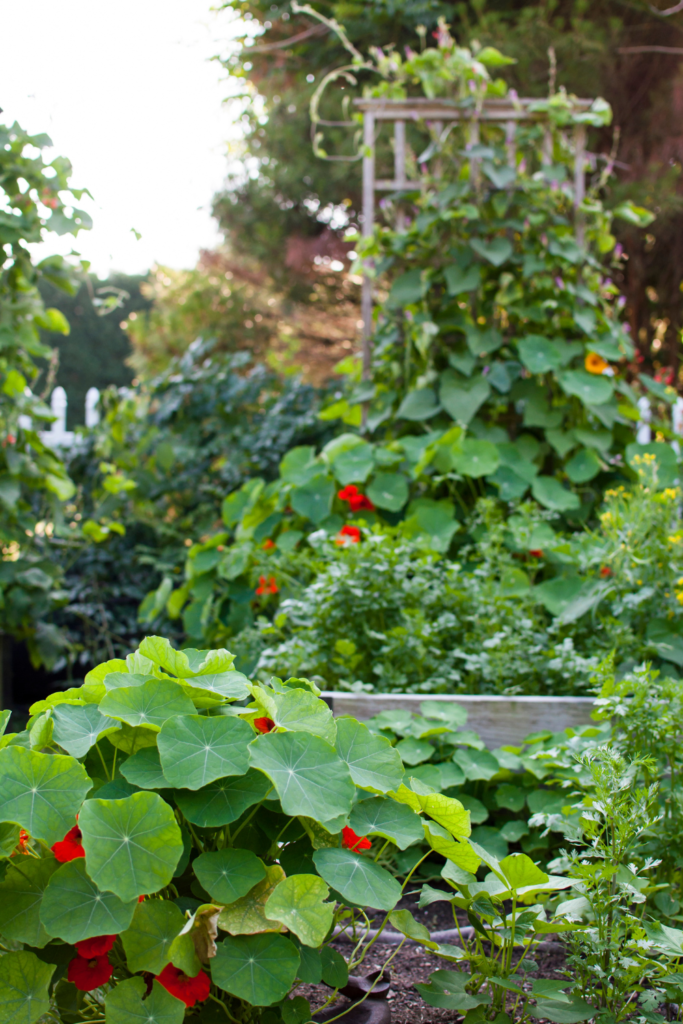
Let’s explore the delightful task of selecting the perfect plants for your vertical garden! I’m thrilled to guide you through this green adventure, where every leaf and bloom adds its own unique charm to your space.
With so many options to consider, from cascading vines to vibrant flowers and lush foliage, it’s like picking out the stars of your own botanical show! Together, we’ll explore the personalities of different plants, finding the ones that thrive in your environment and capture your heart. So, grab your gardening gloves, and let’s get on this exciting journey of choosing the right plants to turn your vertical garden dreams into reality!
Vertical Gardening Plants That Are Flowers
Flowering Plants That Thrive In Vertical Gardening Setups
- Petunias: These colorful annuals come in a wide range of hues and bloom prolifically throughout the growing season. They’re perfect for cascading down walls or hanging baskets in your vertical garden.
- Geraniums: Geraniums are classic flowering plants known for their vibrant blooms and aromatic foliage. They’re versatile and can be grown in containers, window boxes, or vertical planters, adding a pop of color to any space.
- Nasturtiums: Nasturtiums are both beautiful and edible, with vibrant flowers in shades of red, orange, and yellow. They’re excellent for vertical gardening, as their trailing habit creates a stunning cascade of color.
- Begonias: Begonias offers a wide variety of options, including wax begonias, tuberous begonias, and rex begonias, each with its own unique charm. They’re well-suited for vertical gardens due to their compact growth habit and striking flowers.
More Vertical Flowers That You Can Grow!
- Fuchsias: Fuchsias are known for their elegant, pendulous flowers that come in a range of colors, including shades of pink, purple, and white. They thrive in partial shade and are ideal for adding a touch of elegance to vertical garden arrangements.
- Lobelias: These delicate annuals feature cascading foliage and masses of small, vibrant flowers in shades of blue, purple, pink, and white. They’re perfect for adding a soft, trailing element to vertical gardens.
- Climbing Roses: Climbing roses are classic favorites for vertical gardening, with their stunning blooms and climbing habits. Choose varieties suited to your climate and provide adequate support for their vigorous growth.
- Morning Glories: Morning glories are fast-growing annual vines with beautiful trumpet-shaped flowers that open in the morning and close by midday. They’re perfect for adding vertical interest to fences, trellises, or arbors.
- Black-eyed Susans: These native perennials are known for their cheerful yellow or orange flowers with dark centers. They’re drought-tolerant and attract pollinators, making them a great addition to vertical gardens.
- Clematis: Clematis vines offer a stunning display of large, showy flowers in a variety of colors and shapes. With proper support, they can climb trellises, pergolas, or walls, adding vertical interest to any garden space.
These flowering plants not only add visual appeal to vertical gardens, but also attract pollinators, such as bees and butterflies, enhancing the overall biodiversity of your outdoor space.
Vertical Gardening Plants That Are Vegetables
Vegetable Plants That Thrive In Vertical Gardening Setups
- Tomatoes: Tomatoes are classic vining vegetables that thrive when given vertical support. Choose indeterminate varieties, which continue to grow and produce fruit throughout the season. Stake or cage them to keep them upright as they grow.
- Cucumbers: Cucumbers are vigorous climbers that do exceptionally well in vertical gardens. Grow them up trellises, fences, or even A-frame structures to save space and encourage straighter fruits.
- Beans: Pole beans are another excellent choice for vertical gardening. Train them to climb up poles, trellises, or netting, and they’ll reward you with abundant harvests of delicious beans all season long.
- Peas: Peas are cool-season vining vegetables that thrive in vertical gardens, especially in early spring or late summer. Provide them with trellises or netting for support, and they’ll produce sweet and tender pea pods for your enjoyment.
- Melons: While melons may seem like sprawling plants, many varieties can be trained to climb vertically with proper support. Choose compact or bush varieties and provide them with sturdy trellises or slings to support the growing fruits.
More Vertical Vegetables That You Can Grow!
- Squash: Some types of squash, such as zucchini and pattypan squash, can be grown vertically with the help of trellises or A-frame structures. Training squash vines vertically can save space and prevent fruits from rotting on the ground.
- Gourds: Gourds are versatile vining vegetables that can be grown vertically in the same way as other members of the squash family. Choose ornamental or edible varieties and provide them with sturdy support structures to encourage vertical growth.
- Luffa: Luffa, also known as loofah, is a vining vegetable that produces long, cylindrical fruits commonly used as natural sponges. Grow them vertically on trellises or fences for straighter fruits and easier harvesting.
- Malabar Spinach: Malabar spinach is a vining leafy green that thrives in hot and humid climates. Train it to climb up trellises or stakes, and enjoy its tender leaves as a nutritious addition to salads and stir-fries.
- Bitter Melon: Bitter melon, also known as bitter gourd, is a vining vegetable with unique, ridged fruits that have a bitter flavor. Grow it vertically on trellises or fences in warm climates for a bountiful harvest of delicious fruits.
These vining vegetables are not only space-saving, but also highly productive when grown in vertical gardens. With proper support and care, you can enjoy a diverse and abundant harvest of fresh, homegrown produce right from your vertical garden.
Vertical Gardening Plants That Are Fruits
Fruit Plants That Thrive In Vertical Gardening Setups
- Strawberries: Strawberries are ideal for vertical gardening due to their compact growth habit and trailing nature. Grow them in hanging baskets, vertical towers, or even in pockets on a wall-mounted planter for a delicious and decorative harvest.
- Grapes: Grapes are vigorous climbers that can be trained to grow vertically along trellises or arbors. Choose dwarf or compact varieties suited to your climate and provide them with sturdy support structures for optimal growth and fruit production.
- Kiwi: Kiwi vines are fast-growing climbers that produce sweet and tangy fruits rich in vitamin C. Train them to climb up trellises or pergolas in a sunny location, and enjoy a bountiful harvest of fresh kiwis in late summer or fall.
- Passionfruit: Passionfruit vines are tropical climbers that thrive in warm, sunny climates. Grow them on trellises, fences, or pergolas, and they’ll reward you with delicious fruits filled with sweet and tangy pulp.
- Raspberries: Raspberries are deliciously sweet berries that can be grown vertically using trellises or wire supports. Choose erect or semi-erect varieties for easier training and harvesting, and enjoy a continuous harvest of juicy raspberries throughout the summer months.
More Vertical Fruits That You Can Grow!
- Blackberries: Blackberries are another popular berry crop that can be grown vertically in a vertical garden. Provide them with sturdy trellises or fences for support, and they’ll produce abundant clusters of sweet and juicy berries for you to enjoy.
- Blueberries: While blueberries are typically grown as shrubs, certain varieties can be trained to grow vertically in containers or raised beds. Choose low-chill or dwarf varieties suited to your climate, and provide them with acidic soil and ample sunlight for optimal growth and fruit production.
- Figs: Figs are versatile fruit trees that can be grown in containers and trained to grow vertically against a wall or trellis. Choose compact or dwarf varieties suited to your climate, and enjoy a harvest of sweet and succulent figs in late summer or fall.
- Columnar Apples and Pears: Certain apple and pear varieties, known as columnar or cordon trees, are specifically bred for vertical growth. These compact trees can be grown in containers or against a wall or trellis, making them perfect for vertical gardening in small spaces.
- Columnar Peaches and Nectarines: Similar to columnar apples and pears, certain peach and nectarine varieties are bred for vertical growth. These compact trees can be grown in containers or trained against a wall or trellis, providing a space-saving solution for growing fresh, homegrown fruit.
These fruits offer a delicious and nutritious addition to any vertical garden, providing fresh produce right at your fingertips. With proper support and care, you can enjoy a bountiful harvest of homegrown fruits from your vertical garden throughout the growing season.
Creative Vertical Gardening Solutions
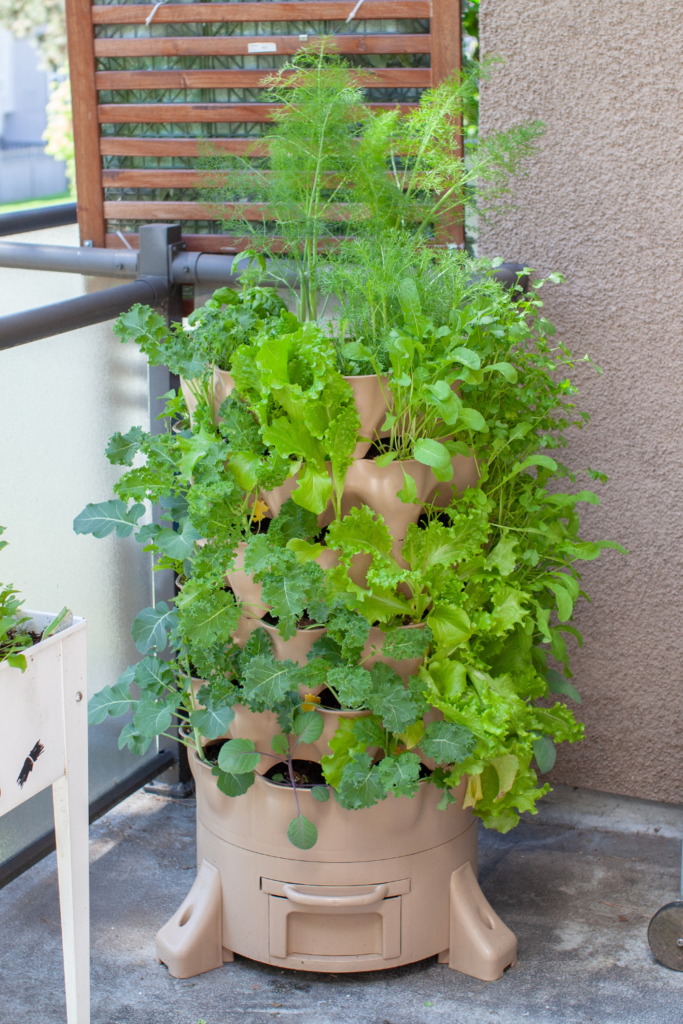
Let’s explore creative vertical gardening solutions by introducing upcycling methods and discovering what the market has to offer! I’m absolutely passionate about finding innovative ways to bring greenery into our lives, no matter how limited our space may be.
With a dash of imagination and a sprinkle of creativity, we can transform even the smallest nooks and crannies into lush, thriving gardens. From repurposing everyday items like shoe organizers and pallets to DIYing vertical planters using recycled materials, the possibilities are endless! So, roll up your sleeves and get ready to think outside the planter box and let your creativity blossom!
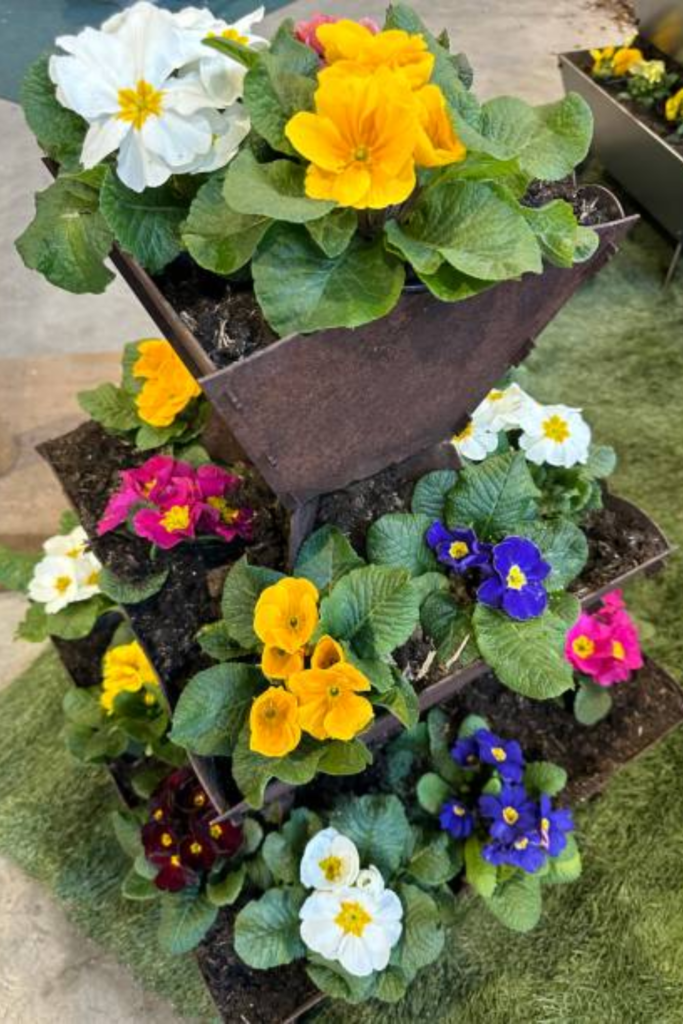
Creative and Upcycled Vertical Gardening Solutions Perfect for Small Spaces
- Shoe Organizer Vertical Garden: Hang a fabric shoe organizer on a fence, wall, or door and fill each pocket with soil and plants. This provides numerous planting pockets without taking up ground space.
- Pallet Planter: Repurpose an old wooden pallet by attaching planters or planting directly into the gaps between slats. Lean the pallet against a wall or fence for a vertical garden with rustic charm.
- Gutter Garden: Mount metal gutters horizontally on a wall or fence to create a sleek and modern vertical garden. Plant shallow-rooted herbs, succulents, or trailing flowers in each gutter section.
- Hanging Basket Tower: Stack hanging baskets of varying sizes vertically using a sturdy support structure. Plant cascading flowers or trailing vines in each basket for a stunning display of greenery.
More Fun Vertical Gardening Projects and DIYs!
- Vertical Herb Garden using Recycled Cans: Collect empty tin cans, paint them in vibrant colors, and mount them on a wall in a vertical row. Fill each can with soil and plant herbs or small flowering plants for a functional and decorative garden.
- Vertical Pallet Herb Garden: Plant small plants in the slabs of a wooden pallet, either horizontally, and fill them with herbs or small plants. Hang the pallet on a wall or lean it against a vertical surface for easy access to fresh herbs.
- Repurposed Ladder Planter: Transform an old wooden ladder into a tiered plant stand by placing potted plants on each step. Lean the ladder against a wall.
- Vertical Terrarium Wall: Create a living wall of succulents or air plants by mounting shallow glass terrariums on a wooden frame or directly onto a wall. Arrange the terrariums in a grid pattern for a visually striking display.
- Recycled Bottle Vertical Garden: Cut the bottoms off plastic bottles and stack them vertically to form planting pockets. Attach the bottles to a wooden frame or wire mesh and fill them with soil and plants for a whimsical and eco-friendly vertical garden.
These creative and upcycled vertical gardening solutions not only maximize space, but also add character and charm to any small outdoor or indoor area. Get creative, repurpose materials, and let your imagination run wild to create a unique vertical garden that reflects your personal style and passion for gardening!
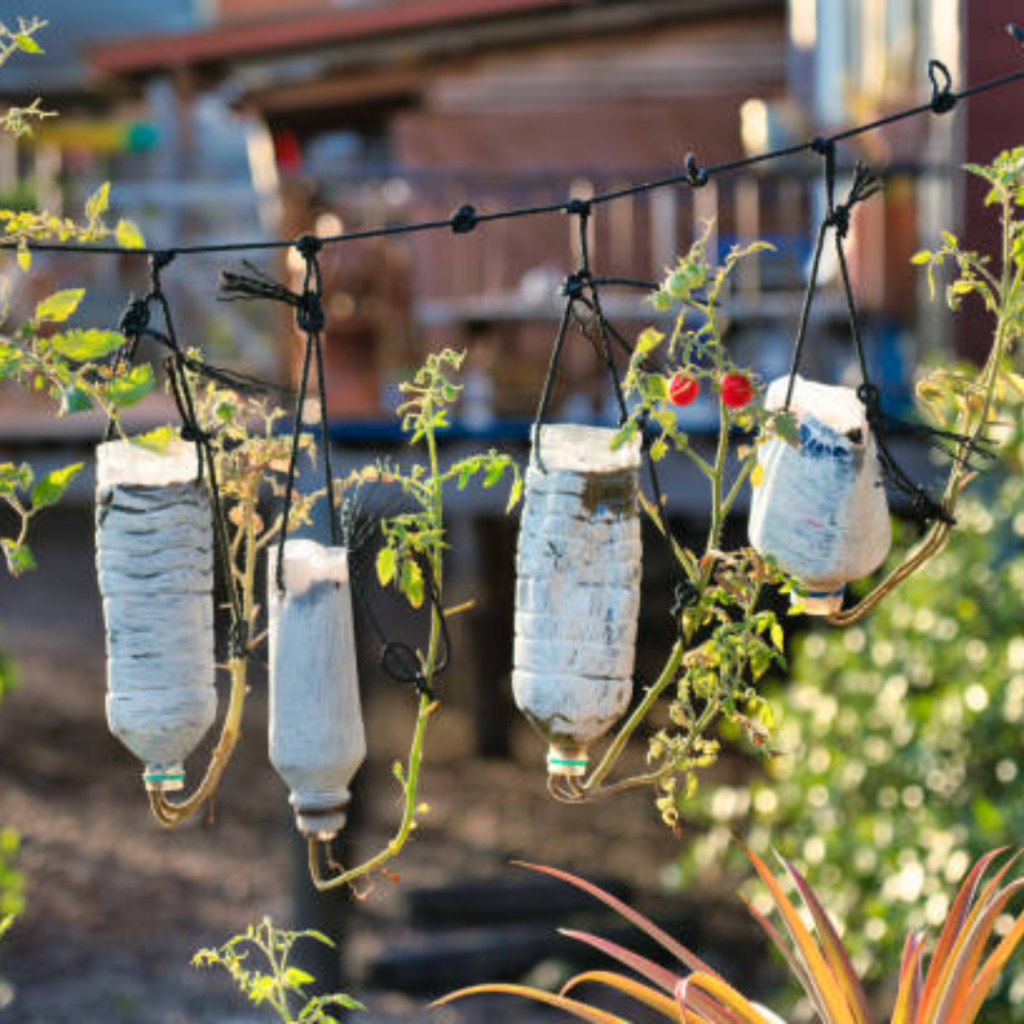
Plant an Upside Down Garden!
Have you heard about upside-down gardening? I’m absolutely thrilled to share with you this innovative and unconventional approach to gardening that turns traditional gardening on its head, quite literally!
Picture hanging baskets overflowing with lush foliage and vibrant blooms, suspended from above, creating a whimsical and eye-catching display. With upside-down gardening, we’re breaking the mold and defying gravity to cultivate greenery in a whole new way. Whether you’re limited on space or just looking to add a touch of uniqueness to your garden, upside-down gardening is an exciting adventure waiting to unfold.
So, grab your gardening gloves, and let’s explore the ins and outs of creating your very own upside-down garden. Get ready to turn your gardening world upside-down, quite literally!
How to Grow an Upside-Down Garden! Psst! No Trellis Is Needed!
- Selecting Containers: Choose sturdy containers such as plastic bottles or buckets with tight-fitting lids. Make sure they are clean and have drainage holes drilled into the bottom for proper water drainage.
- Preparing the Containers: If using plastic bottles, cut off the bottom of the bottle using sharp scissors or a knife. For buckets, drill a large hole in the center of the lid. This will serve as the opening for planting and watering.
- Adding Potting Mix: Fill the container with high-quality potting mix, leaving a few inches of space below the opening. Mix in slow-release fertilizer or compost to provide nutrients for the plants throughout the growing season.
- Planting the Vining Plants: Carefully insert the vining plants through the opening in the container, ensuring that the roots are spread out evenly. For tomatoes and cucumbers, plant one seedling per container. For strawberries, you can plant multiple runners around the edges of the container, each plant poking out from different holes. For flowers, choose varieties that are well-suited for hanging baskets and have trailing growth habits.
- Watering: After planting, water the containers thoroughly until the soil is evenly moist. Allow excess water to drain out through the bottom drainage holes.
More Tips for Upside-Down Gardening!
- Hanging the Containers: Hang the containers from a sturdy support structure such as a hook, pole, or trellis. Make sure they are securely attached and can support the weight of the containers when fully grown with water.
- Supporting the Vines: As the vining plants grow, provide support by tying them to the support structure using soft plant ties or twine. This will prevent them from becoming tangled and ensure proper growth.
- Maintenance: Regularly check the containers for moisture levels and water as needed, especially during hot weather. Fertilize the plants every few weeks with a balanced liquid fertilizer to promote healthy growth and fruit production.
- Harvesting: Once the fruits or flowers start to ripen, harvest them regularly to encourage continuous production. For tomatoes and cucumbers, gently twist or cut the fruits from the vine when they are fully ripe. For strawberries, simply pluck the ripe berries from the plants.
- Pruning: Throughout the growing season, prune away any dead or diseased foliage to maintain plant health and encourage airflow. This will help prevent pest and disease problems and promote vigorous growth.
By following these steps, you can successfully grow vining plants upside down using bottles or buckets, maximizing space and creating a unique and bountiful garden display.
Tips for Maximizing Space In Vertical Gardens

I would like to share some fantastic tips for maximizing space in your vertical garden! I’m absolutely passionate about making the most of every inch of my gardening canvas, and these tips are sure to help you create a lush oasis even in the smallest of spaces.
- First off, consider using vertical structures like trellises, hanging baskets, or wall-mounted planters to elevate your greenery and free up precious ground space.
- Next, get creative with plant selection – opt for compact varieties, trailing vines, and vertical growers to make the most of your vertical real estate.
- Don’t forget to layer your plants strategically, placing taller varieties behind shorter ones to create depth and visual interest.
- And finally, embrace vertical gardening hacks like repurposed containers, hanging shoe organizers, or DIY pallet planters to add even more planting pockets to your space.
With a sprinkle of creativity and these handy tips, you’ll transform any vertical surface into a thriving green paradise in no time!”
Maintenance and Care for Vertical Garden Plants
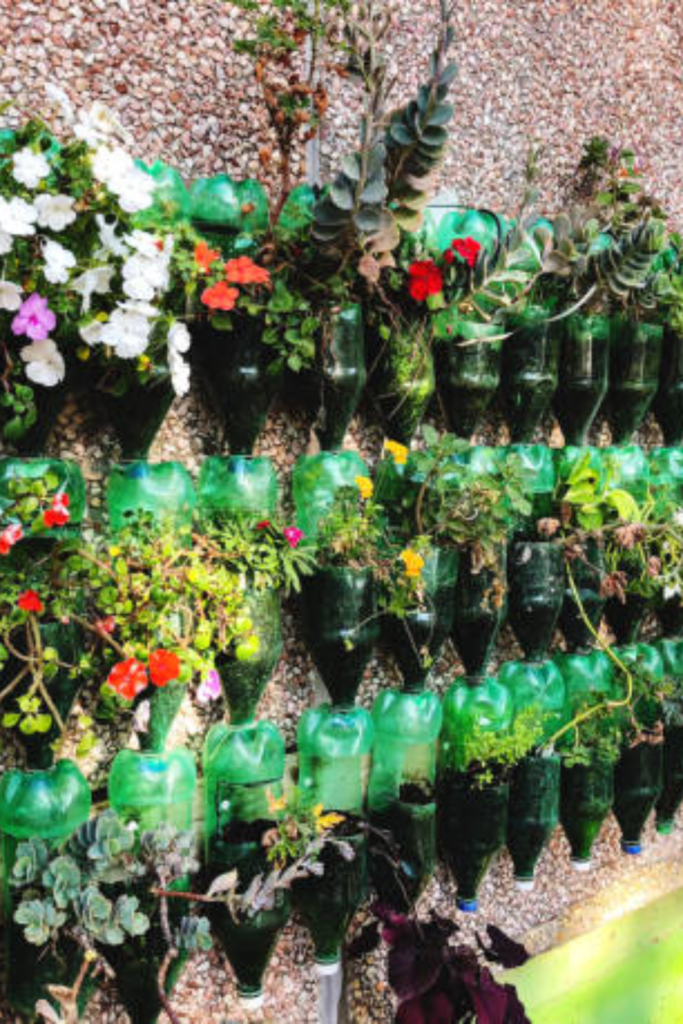
I would like to share with you the essential maintenance and care tips to keep your vertical garden plants thriving! I’m genuinely excited to share these insights because I know how rewarding it feels to nurture our green friends and watch them flourish.
- First things first, make sure to regularly check the moisture levels of your soil, especially in warmer weather, and water accordingly to keep your plants happy and hydrated.
- Secondly, keep an eye out for any signs of pests or diseases and address them promptly to prevent any damage to your precious plants. Don’t forget to fertilize regularly to provide your plants with the nutrients they need to keep growing strong and healthy.
- And finally, give your vertical garden a little TLC by pruning away any dead or wilted foliage to encourage new growth and maintain its beauty.
With a bit of love and attention, your vertical garden will continue to be a vibrant and thriving oasis for all to enjoy!
Watering and Fertilizing Vertical Gardens
Watering and fertilizing are the dynamic duo that keeps our vertical gardens thriving! I’m genuinely excited to share these essential tips because I know firsthand how crucial they are for maintaining our green sanctuaries.
Watering Vertical Gardening Plants
When it comes to watering, consistency is key. I recommend checking the moisture levels regularly, especially during hot spells, and giving our plant pals a good drink when they’re feeling thirsty. During hot spells, plants can quickly dry out, so it’s crucial to keep a close eye on them.
One handy tip is to stick your finger into the soil about an inch deep—if it feels dry, it’s time to water. But remember, it’s not just about quantity; it’s also about technique. Aim to water the soil directly at the base of the plants to avoid wasting water and ensure it reaches the roots where it’s needed most.
And here’s a pro tip: consider investing in a drip irrigation system or self-watering containers for your virtual garden to make watering even more efficient, especially if you have a busy schedule. With a little bit of attention and care, our plants will thank us with lush, green growth and bountiful harvests!
Fertilizing Vertical Gardening Plants
And let’s not forget about fertilizing! Just like us, our plants need their nutrients to grow big and strong. So, don’t hesitate to sprinkle on some plant food every few weeks to keep them nourished and happy.
Fertilizing is like giving our plants a nutritious meal to fuel their growth and vitality. Look for a balanced fertilizer specifically formulated for the types of plants you’re growing in your vertical garden.
Whether it’s a slow-release granular fertilizer sprinkled around the base of the plants or a liquid fertilizer diluted in water and applied during watering, the goal is to provide a steady supply of essential nutrients like nitrogen, phosphorus, and potassium.
By fertilizing every few weeks during the growing season, we’re ensuring that our plants have everything they need to thrive and produce abundant blooms or delicious fruits and vegetables. It’s a small investment that pays off big time in the health and beauty of our vertical gardens!
Pest and Disease Management In Vertical Gardens
I would like to tackle the topic of pest and disease management in our beloved vertical gardens! I’m genuinely passionate about keeping my green sanctuaries healthy and thriving.
Pests In Virtual Gardening Plants
First off, prevention is key, so keep a close eye on your plants for any signs of trouble. Look out for common pests like aphids, spider mites, and whiteflies, as well as symptoms of diseases such as powdery mildew or leaf spot. One of the best ways to deter pests is by maintaining good airflow around your plants and practicing proper spacing to prevent overcrowding.
Disease In Virtual Gardening Plants
If you do spot any unwanted visitors or signs of disease, don’t panic! There are plenty of organic solutions like neem oil or insecticidal soap that can help combat pests, while natural fungicides can tackle fungal diseases. And remember, a little vigilance goes a long way in keeping our vertical gardens happy and healthy!
I have written several other posts about pests and disease and how to grow an organic garden as well as the best trellis to use for vining plants to help you grow a vertical garden, so be sure to check them out!
- The Best Garden Snail Control Strategies
- The Best Tips for Organic Gardening
- How to Release Ladybugs In Your Garden for Organic Pest Control
- How to Effectively Combat Powdery Mildew in Your Garden
- How to Grow Marigolds As Pest Control In Your Vegetable Garden
- The Best Vegetable Garden Trellises for Vining Plants
Conclusion
As we wrap up our exploration of the best hacks for vertical gardening in small spaces, I’m filled with excitement and gratitude for the journey we’ve taken together. I hope you’re feeling inspired and empowered to turn your limited space into a flourishing oasis of greenery and beauty. Remember, whether you’re hanging baskets of vibrant flowers, training tomatoes to climb, or growing strawberries upside down, there’s no limit to the creativity and ingenuity you can bring to your vertical garden. With a little bit of passion, a touch of imagination, and the tips and tricks I’ve shared, your small space can truly become a haven of lush growth and natural wonder. So, let’s roll up our sleeves, get our hands dirty, and continue to cultivate joy and beauty in every corner of our lives. Happy gardening!
Resources: Here are some helpful resources for further information.
- A Complete Guide to Vertical Gardening – By Roots and Refuge (I love her vertical garden techniques and her YouTube channel, so be sure to check her out!)
- How to Grow a Vertical Garden – By Veggie Gardener
- Top 10 Species That Work Best In Vertical Gardens – By Singular Green

Frequently Asked Questions
1. Can I grow vegetables in a vertical garden?
Definitely! Growing vegetables in a vertical garden is not only doable, but it’s also a fantastic way to maximize space and produce a bountiful harvest. You can easily grow a variety of veggies like tomatoes, peppers, lettuce, herbs, and even root vegetables in vertical gardens. Just make sure to choose the right plants for your specific setup and provide enough sunlight and water. Remember that certain vegetables may need deeper pockets or more support as they grow, so plan accordingly when designing your vertical garden. With a little bit of research and creativity, you’ll be enjoying delicious homegrown veggies in no time! Plus, vertical gardens can add some extra greenery to your space and create a visually appealing display.
2. How often should I water my vertical garden?
The frequency of watering your vertical garden depends on several factors such as the types of plants you have, the climate in your area, and the materials used in your vertical garden. Generally speaking, most vertical gardens require watering about once or twice a week. However, it is essential to monitor the moisture level of the soil regularly to ensure your plants are getting enough water. During hot summer months, you may need to adjust your watering schedule more frequently because plants tend to lose moisture quicker in high temperatures. Consider investing in a self-watering system or using a drip irrigation system to make watering your vertical garden more convenient and efficient. Ultimately, finding the right balance will help your plants thrive and maintain a healthy vertical garden all year round.
3. Do I need a lot of natural light for vertical gardening?
When it comes to vertical gardening, natural light is definitely a key factor to consider. Most plants need adequate sunlight to photosynthesize and grow properly, so it’s important to place your vertical garden where it will receive plenty of sunlight throughout the day. Different types of plants have varying light requirements, with some needing more direct sunlight than others. Herbs like basil and rosemary thrive in full sun, while ferns and ivy do well in low-light conditions. If you’re limited on natural light in your space, you can look into supplemental grow lights. You can even choose shade-loving plants for your vertical garden. Overall, ensuring your vertical garden gets enough natural light is essential for the health and growth of your plants.
4. What are some common pests that affect vertical garden plants?
When it comes to vertical gardens, pests can be a real nuisance. Some of the most common critters that can wreak havoc on vertical garden plants include aphids, spider mites, whiteflies, and mealybugs. These pests feed on the plant’s sap, weaken the plant by sucking out vital nutrients, and can also transmit diseases. To keep these pests at bay, regular monitoring is key. You can also introduce natural predators like ladybugs or lacewings to control infestations. Additionally, maintaining good airflow and proper watering techniques can help prevent pest problems in your vertical garden. Remember to regularly inspect your plants for signs of pest damage and take quick action to protect your greens!
Summary
I hope I have inspired you to grow a virtual garden with these tips and products.
If you were encouraged by this post, I invite you to check out my FREE Printables Page for fun free printables, planners, and charts.
ENTER MY FREE Printables Page HERE
Here are some more of my gardening inspiration posts to check out!
Hugelkultur: Does This Epic Pioneering Method Actually Work?
9 Ways to Celebrate Earthing Day in Your Garden!
Gardening Indoors: Secrets of Growing Your Food Inside!
How to DIY a Milk Jug Drip Irrigation System!
Why Cedar Mulch Is The Perfect Natural Weed Barrier
Onions: How to Grow Onions for Storage
Peas: How to Grow Garden Peas for a Bumper Crop
Carrots: How to Grow Carrots for a Bountiful Harvest
Prep Your Garden for Spring Planting with These Expert Tips!
How to Grow a Prepper Garden to Survive and Thrive
The Best Garden Tools You Need for a Productive Season
Fastest Growing Vegetables for Your Survival Garden
How to Grow Marigolds As Pest Control In Your Vegetable Garden
Must-Have Tools for a Successful Balcony Vegetable Garden
How to Effectively Combat Powdery Mildew in Your Garden
The Best Tips for Organic Gardening
How to Release Ladybugs In Your Garden for Organic Pest Control
The Best Garden Snail Control Strategies
The Best Spring Vegetables to Grow in Your Garden
Seed Starter Mix: How To Make Your Organic Seed Starter Mix At Home
How to Grow a Productive Canning Garden
How to Plant and Grow a Salsa Garden
Easiest Heirloom Vegetable Seeds to Grow Now
How to Use the Hand Twist Claw Tiller: Tackling Tough Soil
More Fun Gardening Posts to Check Out!
Planning Your Garden: How to Plan a Vegetable Garden: Expert Green Thumb Tips!
Winterizing the Garden: How to Winterize Your Vegetable Garden: Step-by-Step Checklist
Mulching the Garden: How to Make Leaf Litter Mulch
Grow a Pumpkin Patch: How to Grow a Pumpkin Patch in Your Backyard
How to Grow a Fall Garden: 9 Best Fall Crops
Clever Ways to Incorporate Indoor Composting into Your Home
How to Start Composting for the Garden: A Step-by-Step Guide
The Ultimate Guide to Composting in Your Suburban Backyard
Why I Built A Survival Garden in My Backyard
16 Best Medicinal Herbs to Grow in Your Garden Now
Blessings,
The Off Grid Barefoot Girl

